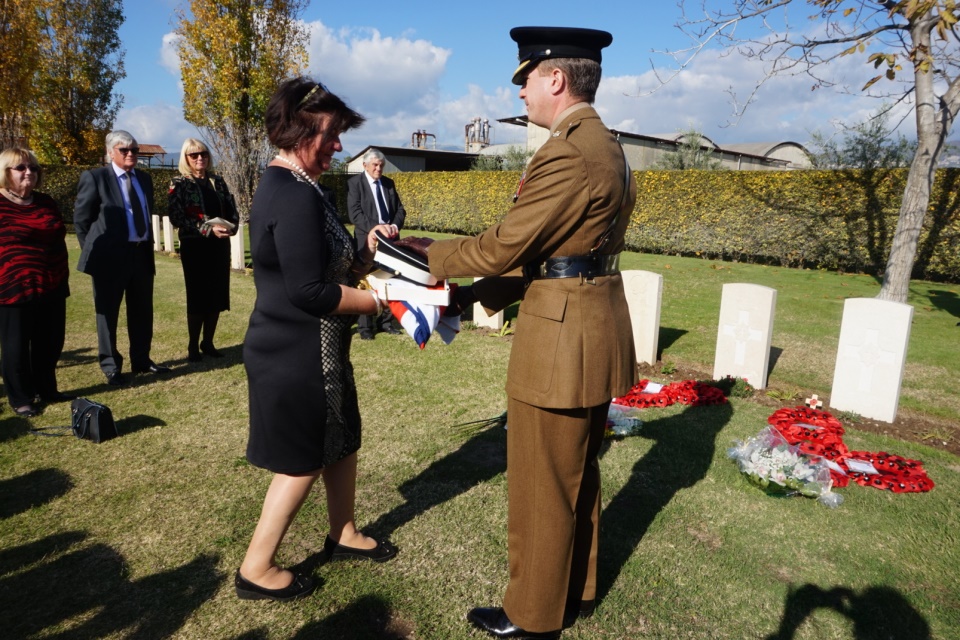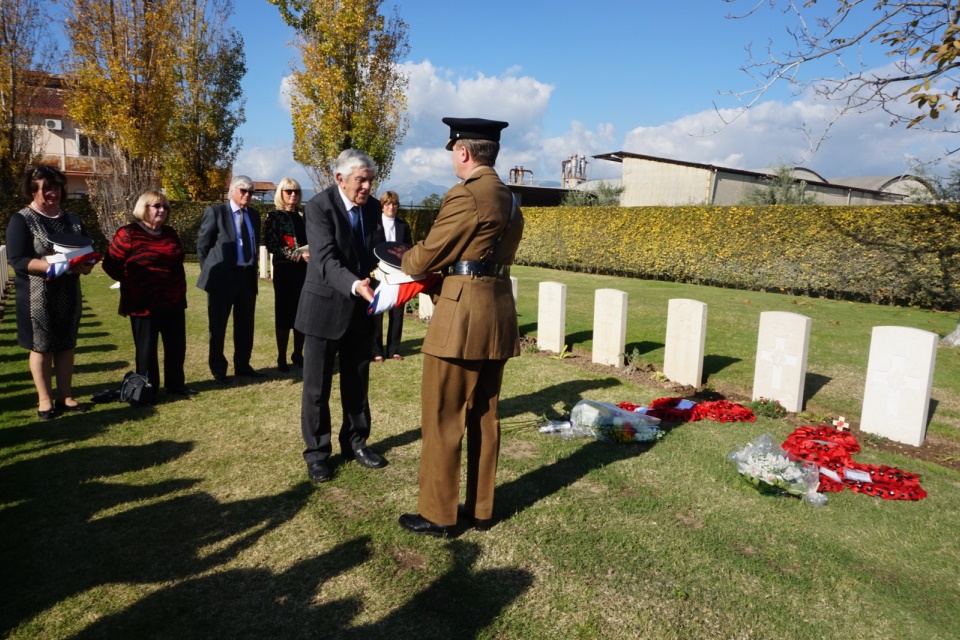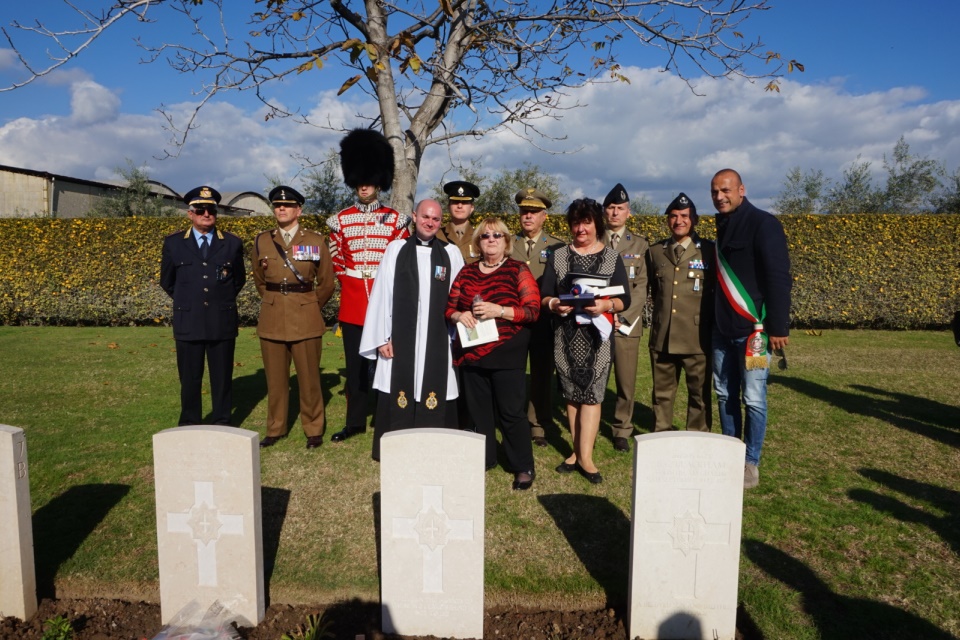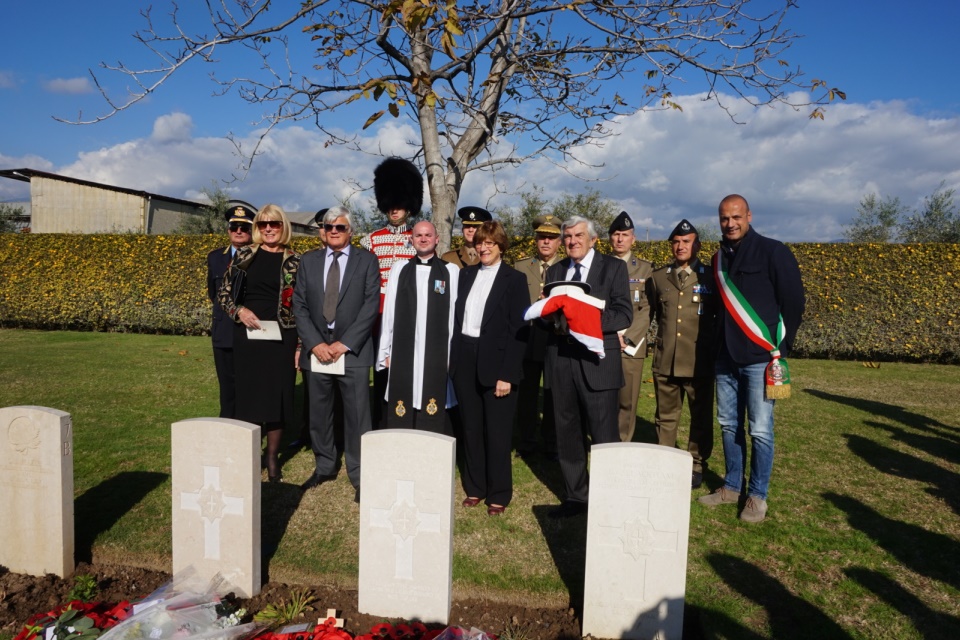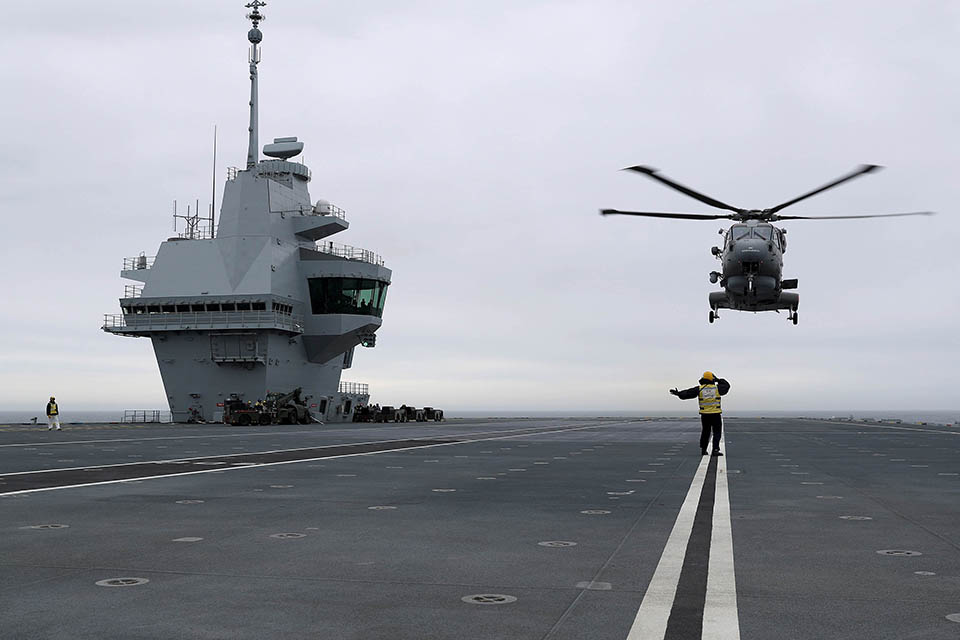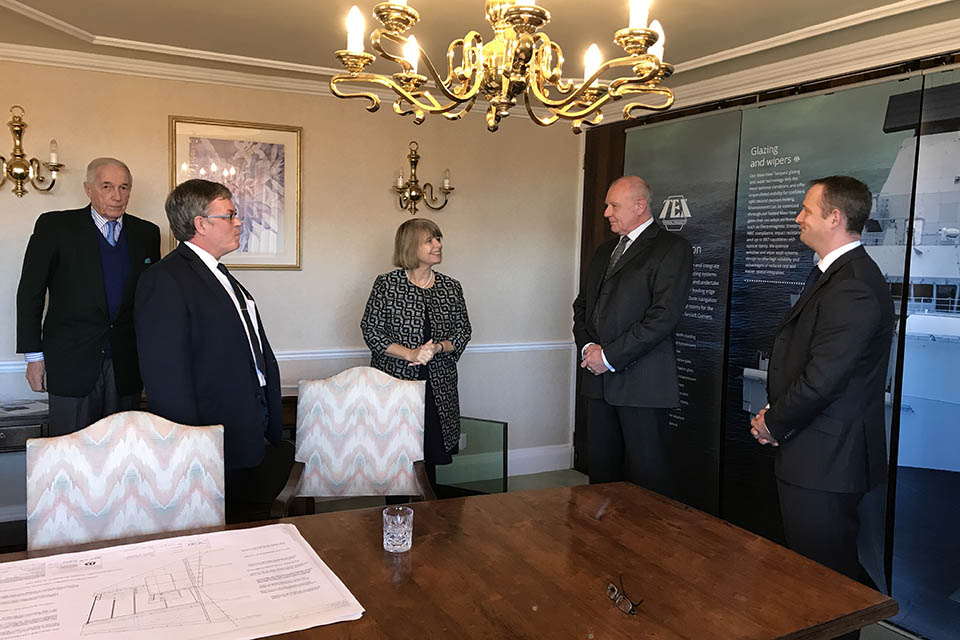It is a privilege to be here at RUSI, and to have the opportunity to deliver this prestigious annual lecture, particularly at this moment in time, as we prepare to enter the fifth and final year of commemorations for the centenary of the First World War, and as the government considers the role our armed forces must play in a world which, sadly, seems to be growing more competitive once again.
As First Sea Lord, I have had the honour of representing the Royal Navy at a number of Centenary events.
Last summer, I was in Orkney as the whole country paused to remember the Battle of Jutland, perhaps the most consequential 36 hours of the whole war…although that’s a debate for another time!
Also last summer, at Thiepval, and earlier this year at the Menin Gate in Ypres, I joined my fellow service chiefs to commemorate the battles of the Somme and Passchendaele, and also to represent the somewhat overlooked contribution of the Royal Naval Division, the Royal Naval Air Service and the Royal Marine Artillery among the trenches and barbed wire of the Western Front.
Yet the Gallipoli Campaign has a special interest for me, both professionally and personally.
As a former commander of the Royal Navy’s Amphibious Task Group, and as someone whose own formative naval experiences were in San Carlos Water 35 years ago, I have always been conscious that the Gallipoli landings sowed the seeds for what we now term amphibious and littoral operations.
Although bitter, the lessons would prove central to the success of the allied landings in Sicily and Normandy in the Second World War, and they continue to resonate today, albeit in an ever-evolving form.
To that end, I intend to dedicate a good proportion of my remarks today to exploring what the future holds for the Royal Navy and Royal Marines in this area.
But I want to start by reflecting on the Anglo-French naval action to open the Dardanelles which proceeded the landings.
The reason I choose this aspect is that it challenges today’s naval and military leaders to consider how we will operate and fight together in a contested battlespace.
Dardanelles Campaign
As many of you will know, the Dardanelles is a 40 mile strait separating Asia and Europe.
Visiting there as Fleet Commander in the destroyer HMS Duncan in 2015 for the Centenary, I was struck by just how exposed any military force attempting to force passage through the Strait must have been.
The opening is guarded by the rocky peaks of the Gallipoli Peninsula and at its narrowest point the channel is only a mile wide. The water flows in both directions, which produces difficult opposing currents on and below the surface. Even for experienced navigators, it is an extremely testing stretch of water.
Nevertheless, the First Lord of the Admiralty at the time, an irrepressible fellow by the name of Churchill, had devised an audacious plan for the Royal Navy to punch its way through the Dardanelles in order to attack Istanbul and knock the Ottoman Empire out of the war.
With fighting on the Western Front bogged down in a slow and costly war of attrition, he wanted to reboot the allied war effort with a quick and easy win.
And yet there was a fatal flaw in this plan. Both he and the allied commanders had massively underestimated the ingenuity, and tenacity, of their enemy.
Hundreds of mines had been spread across the channel and, with German assistance, the Ottomans had strengthened the defences around the narrows and introduced new mobile artillery along the clifftops.
Today we would term these disruptive technologies; the Ottoman forces were much faster to grasp their potential and were able to apply them to a theatre they knew well with devastating success.
The principal day of naval action saw 3 allied battleships sunk, and a further 3 crippled.
The conduct of the subsequent landings was better but still hampered by a chronic lack of skilled coordination between the British Army and the Royal Navy, and the ‘trenchlock’ realities of the period prevented them from developing much beyond the beachhead.
To borrow a phrase from Napoleon: one service was an elephant, the other was a whale, and neither really understood how to flourish in the other’s environment.
Contested waters
So why is this relevant today?
Just as commanders at Gallipoli faced new and unfamiliar multi-dimensional threats, notably the combination of artillery from above and mines from below, today the armed forces must work in an increasingly complex battlespace.
We feel this acutely in the Royal Navy, operating as we do above and below the waves, over the land, in the air and in cyberspace.
Since the end of the Cold War, Western navies have, by and large, enjoyed a degree of superiority at sea which enabled us to work across all these domains unimpeded.
And yet today, the space in which we operate is becoming more congested and contested.
Part of this is technological. Conventional weapons which deny navies freedom of navigation are proliferating.
The most obvious examples are underwater.
Today there are almost 500 submarines operated by 40 navies.
Nuclear boats remain in a league of their own, but the latest conventionally powered submarines are quieter, more reliable and better operated than their diesel equivalents of yesteryear.
The same is true for sea mines, which remain cheap, easy-to-use and plentiful.
Stockpiles held by North Korea and Iran are estimated to be in the thousands, globally the figure could run into the hundreds of thousands.
Thanks in part to the internet, knowledge of how to use them is spreading too, as we’ve seen from devices deployed off Yemen recently which, incidentally, is the 22nd global mining event since the Second World War.
Those of you who heard me speak at DSEI in September will know the Royal Navy plans to accelerate the introduction of autonomous mine hunting systems, and this is one reason why.
But as well as being more contested from a technological perspective, the maritime domain is also becoming more congested as a result of broader geo-strategic trends.
You don’t need to look very far to see rising and resurgent powers flex their muscles.
It’s now clear that the peaks of Russian submarine activity that we’ve seen in the North Atlantic in recent years are the new norm.
The same is true of the steady stream of vessels passing the UK on their way to join the Baltic, Mediterranean and Black Sea Fleets.
It’s not all about our old friends in the North.
China’s navy now sustains routine deployments to the Middle East, Somali Basin and Gulf of Guinea.
Earlier this year we saw a joint Russian-Chinese naval exercise in the Baltic. Suddenly, our own European backyard is a little more crowded.
To quote my friend the US Chief of Naval Operations,
the era of uncontested maritime superiority is fading.
Our response cannot simply be to avoid operating in these environments; we don’t have that luxury.
Areas of enclosed water, like the Baltic and the Persian Gulf, are essential to global security today, and will remain so.
Over the coming decades, more and more of the world’s population will be concentrated in coastal regions; and with growing population comes the opportunity for greater economic, political and military power.
This is where the conflicts of the future will happen, and if governments wish to influence events then they must be prepared to act in this space.
The inherent mobility, flexibility and capability of maritime forces provides military and political choice, which is why it remains the favoured means of power projection for western governments, and for aspiring military powers.
I certainly sense no appetite in the West to commit forces ashore in large numbers; whatever the dangers found at sea, the risks of enduring land operations are greater still.
But in any case, the distinction between all these domains is becoming more blurred
We have no choice but to operate across all these domains and to meet conventional and unconventional threats in equal measure.
Reshaping the Royal Navy
So what does this mean for the UK?
Two weeks from today, in the presence of Her Majesty the Queen, we will hoist the White Ensign from the largest ship ever built for the Royal Navy.
Of course, aircraft carriers, like nuclear submarines, are strategic instruments, indicative of an ocean-going navy and a global maritime power.
They may be operated by the Royal Navy, but these ships will sit at the heart of joint and coalition operations.
In particular, I have every expectation that the pairing of the Queen Elizabeth class carriers with their fifth generation F35B Joint Strike Fighters will quickly become a valued asset, in constant national and coalition demand.
Inevitably, the carriers will operate in areas of heightened tension, and in proximity to the threat.
The Royal Navy feels a particular sense of responsibility in this enterprise.
Much of our organisation is being reshaped in order to generate and sustain a Carrier Strike Group with all the resilience needed to ensure that we, the navy, can match the expectation that this phenomenal capability represents for the UK armed forces as a whole.
We’ve done a lot of work to consider what a comprehensive, sovereign UK Carrier Strike group should look like.
It will vary according to the circumstances of each deployment, but in a high threat environment we would expect a carrier to be accompanied by 2 destroyers for air defence, 2 frigates for anti-submarine protection, a tanker and a solid support ship, together with an attack submarine held on a reasonably tight rein.
Of course, with a force of 19 frigates and destroyers, this will necessitate a change to how the navy delivers some of its other commitments.
The new Offshore Patrol Vessels and subsequently the Type 31e frigates will pick up many of our fixed tasks, freeing up the more complex Type 26 frigates and Type 45 destroyers for their core roles in support of Carrier Strike and the Nuclear Deterrent.
This represents a return to the concept of balance fleet which has been the historical norm for the Royal Navy.
To this core we can add other specialist vessels as required, and we expect to integrate ships and aircraft from partner navies too.
Nor should we forget the Royal Air Force’s P8 Maritime Patrol Aircraft, or the Fleet Air Arm’s Crowsnest Airborne Surveillance and Control System, both of which sit at the outmost layer of defence.
But, at the heart of it all, is the F35B.
The Joint Strike Fighter represents a quantum leap over anything we’ve operated at sea before, combining the traditional qualities of speed and manoeuvrability with the 21st century advantages of stealth, electronic attack and sensor fusion.
The vast majority of enemy fighters will likely never know they are targeted by the F35B until the weapon impacts.
The Royal Navy is proud to boast genuinely world beating capabilities that will sit within the Carrier Strike Group, and we use them with skill.
This is an important point because sometimes, we take the claims of other nations at face value, without being even handed in our critical analysis.
I hear quite a lot of ill-informed commentary about so called “carrier killer” hypersonic missiles.
These are still in the development stage. At some point, they may pose a threat, but this would apply on land as it does at sea.
However, the great advantage of a Carrier Strike Group remains the fact that you can move it out of harm’s way covertly and you can keep doing so as circumstances demand.
But the crucial point here is that while our adversaries may be pursuing new technologies, so are we.
In the coming years we will test the UK’s first directed energy weapon from a Royal Navy ship.
This kind of system will be able to provide close-in protection for naval vessels operating near to shore, while high powered microwave systems, also under development, will disrupt sensors and communications.
Last month, I visited the US Navy’s surface warfare laboratory in Virginia to learn about their electromagnetic rail gun.
This can project a tungsten warhead at a target 110 nautical miles away. It arrives at Mach 9, and can pass through 9 inches of steel.
In time, all these weapons will have a role to play in countering a swathe of emerging threats across land, sea and air, including hypersonic and ballistic missiles, drones and fast intercept craft, and our new Type 26 frigate is designed with the power and space requirements to integrate these systems as they reach maturity.
The future of Royal Marines
So what is the place of amphibious warfare in this new carrier centric era of maritime power protection?
The truth of the matter is there are few elements of our armed forces more feared by our enemies, or more respected by our allies, than the Royal Marines.
Only last week, the Royal Navy and the Turkish Navy participated in NATO amphibious training in the Eastern Mediterranean.
As Turkey develops its own amphibious capability, centred on introducing 2 new LHDs into service, they naturally look to the UK and the Royal Marines for assistance.
As I mentioned earlier, my own formative experience in the Royal Navy was serving in the assault ship HMS Fearless during the Falklands War.
I have subsequently had the privilege to serve alongside, or to lead, Royal Marines at every stage of my career, including commanding the Amphibious Task Group 10 years ago.
The Royal Marines are an inseparable part of our naval family, and as Head of Service I will fight for them every step of the way.
And yet I recognise that, together, the Royal Navy and Royal Marines must adapt to meet the challenges of the maritime century.
Let me explore this in a little more detail.
In the course of my career, I have seen assumptions about the nature of amphibious warfare change time-and-again.
Throughout the Cold War, with most of the British Army committed to Germany, the primary wartime purpose of the Royal Marines was to bolster NATO’s northern flank in Norway, to slow the advance of Soviet forces long enough for reinforcements to arrive.
Then, in the 1990s, it was all change. The Royal Marines were now the vanguard of the Royal Navy’s transformation into an expeditionary tool. This reflected the Blair government’s ambition for the UK armed forces to be a “force for good” in the world and was perhaps best exemplified by our intervention in the Sierra Leone civil war in 2000.
Finally, in the last decade, as the UK’s involvement in Iraq and Afghanistan deepened, increasingly the Royal Marines found themselves serving, with distinction, in an infantry role ashore alongside the army.
In each of these cases, the Royal Marines were the ‘first to adapt, the first to overcome’ and now, as the Royal Navy looks forward to a new carrier centric future, they must do so again.
However, I want to be clear that this does not mean our investment in Carrier Strike comes at the expense of the Royal Marines.
The different core capabilities within the naval service undergo the cycle of renewal at different times.
Fifteen years ago, much of our naval investment was directed toward the Royal Marines, as we conducted operations in Iraq and Afghanistan, recapitalised our amphibious shipping, and introduced new Offshore Raiding Craft and Viking Protected all-terrain vehicles.
So while Carrier Strike and the Deterrent now take their turn in the cycle of renewal, this in no way lessens the continuing importance of the Royal Marines.
Indeed, the responsibilities, and opportunities, of this new era for the naval service are shared across our 5 fighting arms.
For the Royal Marines, these responsibilities begin at home.
43 Commando continue to protect the Nuclear Deterrent and the Corps is making a growing contribution to domestic counter-terrorism, which has sadly seen them activated twice this year for Operation Temperer.
The Lead Commando Group continues to serve as the UK’s ‘go-to’ high readiness force. They were at the forefront of our disaster relief efforts in the Caribbean in September; and next year they will head to the Gulf and to India with the Joint Expeditionary Force for large scale exercises.
Meanwhile, SDSR 15 confirmed investment in the amphibious capabilities of our Queen Elizabeth class carriers and the modernisation of the Commando Helicopter Force is underway.
Beyond these core roles, the work of ship’s protection and boarding teams, the fleet standby rifle troop, and of international training teams around the world, continues.
As I speak a Royal Marine training team is in Taranto working with the Libyan Coastguard to help develop the skills they will need to better police their troubled coastline.
So the Royal Marines are today every bit as vital to the work of the Royal Navy, and of defence more broadly, as they have been throughout the last 350 years.
Nevertheless, the concepts and capabilities that shape how we operate in the littoral will continue to change, and by the 2030s they will look different to how they appear today.
Work to understand and develop this requirement began long before the National Security Capability Review, and is being led from within the Corps.
Through the development of Special Purpose Task Groups, 3 Commando Brigade is now able to offer something new to defence, in the form of scalable teams of Royal Marines with tailored skills and capabilities that can be deployed in theatre, or held at high readiness, to provide military choice.
Meanwhile, 42 Commando has transformed into a dedicated maritime operations commando to work alongside our sailors in a variety of roles; a move that reflects the historical roots of the Corps.
As for specialist shipping, in the longer term we may opt for multi-role platforms which can provide amphibious capabilities, but can also serve as an afloat forward base for a range of enduring maritime security tasks.
The Type 31e General Purpose Frigate will also provide an ideal platform to host an embarked military force, forward deployed to British Overseas Territories, and to regions of concern to the UK.
While all this points to a more agile approach, we should not discount the future requirement to provide amphibious forces at scale to deliver theatre entry from the sea.
Our experience of the Snatch Land Rover in Iraq and Afghanistan highlighted the vulnerability of lightly armoured vehicles. As a result our newer, better armoured, equipment is progressively heavier, but in some cases too heavy to be lifted by air.
Of course, no one envisages sending landing craft full of Marines to storm an enemy beach under a hail of fire.
That model is, we hope, consigned to the history books; but in instances where aviation lift is unavailable or insufficient it may still be necessary to offload large numbers of personnel and heavy equipment from the sea, ideally at a port but if necessary over a beach, however that might be achieved.
Finally, when considering the role of the Royal Marines, we mustn’t overlook the most important element of all, and the only capability in defence which is truly ‘exquisite’, I am, of course, referring to people.
The future operational environment will demand more than just blunt force, it will require nuance and sophistication.
In Afghanistan, 3 Commando Brigade learnt a huge amount about civil-military cooperation, cultural awareness, and the importance of understanding the pattern of life among scattered tribal villages.
We need to retain and develop this insight, because it will be just as relevant to rapidly growing urban populations in failed and failing coastal states, or among mariners and fishermen working in the vital maritime choke points which govern the flow of maritime trade.
Within this, there is a huge role for information superiority. 30 Commando are world leaders in information exploitation and the Royal Marines were front and centre of last year’s Exercise Information Warrior.
The Royal Marines have always been the thinking man’s solider.
Today 17% of marines have degrees and 40% have the educational qualifications for officer selection.
They remain experts in urban, mountain and arctic skills.
These are the men, and in future the women, who can build understanding, exploit technology and, when required, strike with precision.
And they have rarely been more relevant to the threats we face.
So be in no doubt: even as the Royal Navy enters a new era of carrier operations, the Royal Marines are bound into the future our service, and of our national defence, in every way.
Conclusion
We have drifted a long way from the Gallipoli Peninsula.
But, in sum, with global populations becoming even more concentrated in the world’s coastal regions, the UK armed forces must be ready to operate seamlessly from the sea to the land, and across all domains.
Let me draw this to a close by reflecting on the words of General Hamilton, commander of the British Mediterranean Expeditionary Force, to Lord Kitchener, the Secretary of State for War, in May 1915.
The Royal Navy has been father and mother to the Army. Not one of us but realises how much he owed to Vice Admiral de Roebeck; to the warships, French and British; to the destroyers, minesweepers, picket boats and their dauntless crews; who took no thought of themselves but risked everything to give their soldier comrades a fair run at the enemy.
Amidst the somewhat dispassionate analysis, we must never forget that the men and boys of the Royal Navy and of all the allied forces, showed immense fortitude and bravery, and they paid a terrible price, as did the Ottoman forces.
The best way we can keep alive the memory of all those who fought and died in the Gallipoli Campaign is by learning the hard won lessons of their experience, so that we may prosper by them.
